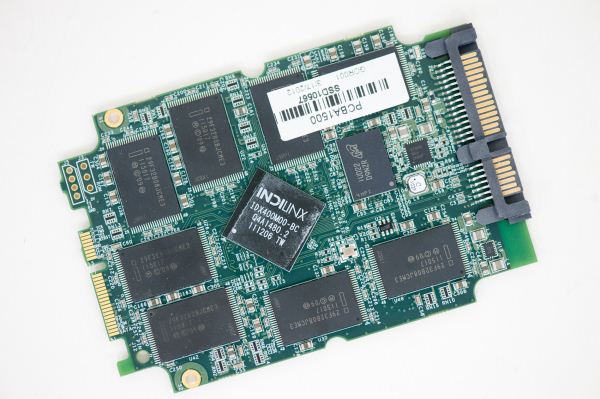OCZ Vertex 4 Review (128GB), Firmware 1.4/1.5 Tested
by Kristian Vättö on August 4, 2012 10:00 AM ESTFinal Words
The latest Vertex 4 firmware updates provide a noticeable boost in sequential write speed at 128GB and 256GB capacities, and the low queue depth sequential read performance issue has also been fixed. Our primary complaints from the initial review, at least from a performance perspective, have been addressed.
That being said, there's still room for improvement. Small file size sequential read performance needs work. Thankfully most sequential reads in client workloads tend to be in the sweet spot for the Vertex 4, but there are some applications that do a lot of small sequential IO (e.g. web browser cache accesses).
The Vertex 4 continues to do a great job addressing one of the major performance issues with SSDs: maintaining great write performance. The V4 always tested very well under the most strenuous of circumstances. Now the trick is bringing mass appeal to the drive, which is admittedly more about ensuring compatibility and reliability than improving performance with small files.
OCZ's new performance mode in the Vertex 4's firmware is pretty unique. While the specifics of what's going on internally are unknown, (somewhat) dynamically switching between performance states depending on the amount of space used on the drive is an interesting idea. I don't know how practical it is for the majority of users (I tend to run most of my drives well above 50% capacity), but innovation should always be encouraged. In this case, it's innovation that's the direct result of having complete access to the controller's firmware - an important step for OCZ in its evolution as a drive maker.











60 Comments
View All Comments
hybrid2d4x4 - Tuesday, August 7, 2012 - link
I agree with this. I care more about power consumption than incremental performance since I only have an SSD in my laptop for now, and the next one I buy will replace that 128GB F120 and my HTPC and eventually desktop will get them as hand-me-downssswing - Saturday, August 4, 2012 - link
Now it looks like we need a review comparing VTX4-25SAT3-512G & VTX4-25SAT3-512G.M since I haven't been able to find updated specs from OCZ. There's a big price difference but is the performance difference relatively equivalent?Movieman420 - Saturday, August 4, 2012 - link
Actually Ocz has been fore-warned not to repeat the same stunt they pulled when they switched from 34nm 32Gb dies to 25nm 64Gb dies without making it clear that there was a significant performance difference...esp with the 50 & 60gb drives that went from using 8 nand chips (1 per SF channel) to using only 4 chips and 4 channels. Anand took Ryan Peterson to task over the stunt and Ryan promised to differentiate models who's speed change by 5% or more I think.The '.M' drives with Micron nand are slower than the regular V4 with IMFT nand
Here's the thread at Ocz.
http://www.ocztechnologyforum.com/forum/showthread...
menting - Sunday, August 5, 2012 - link
huh? Micron NAND IS IMFT NAND.what was that support guy smoking?
semo - Monday, August 6, 2012 - link
Just to add that not only did the performance suffer but the capacity did as well. They also used Spectek NAND which wasn't what the reviews reported originally.In the end, OCZ managed to bury the issue without even issuing a mass recall of the affected drives. OCZ is a dodgy company and I'm glad that there is enough competition out there for me to avoid buying any of their products.
primeval - Saturday, August 4, 2012 - link
The performance is great and all, but without reliability I just don't see that many people jumping on board. No one wants to replace their SSD frequently.chaudx - Saturday, August 4, 2012 - link
How much of a drop in performance do other drives take when over 50% full?Benchmarking empty drives seems like a waste of time, as most people are going to fill them at least 50%, if not more.
Linuxhippy - Saturday, August 4, 2012 - link
What I really miss is an analysis, how much used capacity affects real-world performance.This way, it looks just a lot like an advertising campaing bought by OCZ ...
The review reminds me a lot about the SandForce benchmarks, where you had to subtract -25% once the drive had been written its capacity for the first time.
AFUMCBill - Saturday, August 4, 2012 - link
Anyone needing an SSD in a video recorder such as the Black Magic Design Shuttle 2 now knows to stay away from this drive. A real time application like that is going to be utterly intolerant of the drive deciding it needs to take a large timeout half way through. I am sure there are other applications in a similar situation to that.Beenthere - Saturday, August 4, 2012 - link
The way these companies rush out half-baked software, firmware and hardware is a crime. They should all be severely punished financially for using consumers as unpaid beta testers.If they continue to do this the executives of these companies should do prison time. This would reduce the exploitation of consumers and bring some sanity and integrity to business. Tolerating the illegally gotten industry monopolies and product price fixing sent a clear message to these criminals that anything goes and as such they are cashing in and using the media to further their unscrupulous behavior.